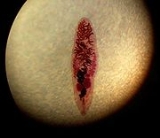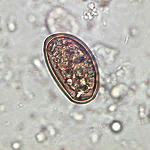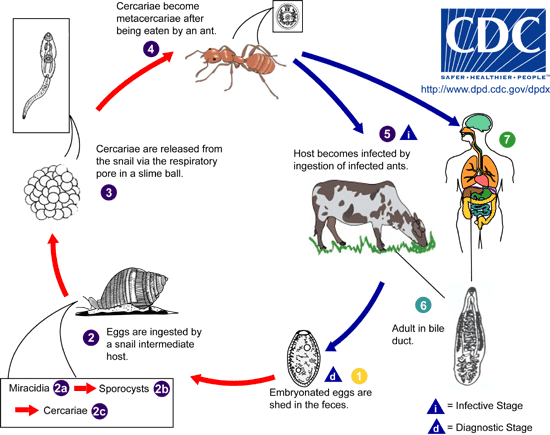
Dicrocoelium dendriticum
Encyclopedia
The Lancet liver fluke (Dicrocoelium dendriticum) is a parasite fluke
that tends to live in cattle
or other grazing mammals.
(synonym: Cionella lubrica). Next came the discovery that the slime balls coughed up by the snails could be a potential method of transfer of the parasite. Shortly thereafter, the ant, Formica fusca was found to be the second intermediate host by which sheep were infected. The knowledge they generated is the foundation of our understanding of the parasite today.
) or inflammation of the liver (cirrhosis
). In one unique case, an infection with Dicrocoelium dendriticum was associated with a skin rash urticaria
.
s and alpaca
s.
 Dicrocoelium dendriticum has a similar morphology to Clonorchis sinensis
Dicrocoelium dendriticum has a similar morphology to Clonorchis sinensis
, the Chinese liver fluke. Dicrocoelium dendriticum is distinguished by lobed testes in the anterior of the body, as opposed to Clonorchis sinensis whose testes are located in the posterior. They both are flat and have a characteristic taper at the anterior and posterior ends. The anterior is distinguished by an oral sucker
at the point, an acetabulum and the testes. The posterior is where the uterus lies. In the parasite’s mid-section lie the vitelline glands that are involved in egg formation.
 Dicrocoelium dendriticum spends its adult life
Dicrocoelium dendriticum spends its adult life
inside the liver
of its host
. After mating, the eggs are excreted in the feces
.
The first intermediate host, the terrestrial snail
(Cochlicopa lubrica
in the United States), eats the feces, and becomes infected by the larva
l parasites. The larvae (or miracidium
) drill through the wall of the gut and settle in its digestive tract, where they develop into a juvenile stage. The snail tries to defend itself by walling the parasites off in cysts, which it then excretes and leaves behind in the grass.
The second intermediate host, an ant
(Formica fusca
in the United States), uses the trail of snail slime as a source of moisture. The ant then swallows a cyst loaded with hundreds of juvenile lancet flukes. The parasites enter the gut and then drift through its body. Most of the cercariae encyst in the haemocoel of the ant and mature into metacercariae
, but one moves to the sub-esophageal ganglion
(a cluster of nerve cells underneath the esophagus
). There, the fluke takes control of the ant's actions by manipulating these nerves. As evening approaches and the air cools, the infected ant is drawn away from other members of the colony and upward to the top of a blade of grass. Once there, it clamps its mandible
s onto the top of the blade and stays there until dawn. Afterward, it goes back to its normal activity at the ant colony. If the host ant were to be subjected to the heat of the direct sun, it would die along with the parasite. Night after night, the ant goes back to the top of a blade of grass until a grazing animal comes along and eats the blade, ingesting the ant along with it, thus putting lancet flukes back inside their host. They live out their adult lives inside the animal, reproducing so that the cycle begins again. Infected ants may contain 100 metacercariae, and a high percentage of ants may be infected. Typical infections in cattle may be in the tens of thousands of adult worms.
The life cycle of Dicrocoelium Dendriticum was illustrated in a humorous comic by The Oatmeal
titled "Why Captain Higgins is My Favorite Parasitic Flatworm" in which the lancet fluke is referred to as "Captain Higgins".
In animals, diagnosis has traditionally involved stool examination or post-mortem examination of the liver. Recently, an ELISA
using a Dicrocoelium dendriticum antigen was able to identify cases of dicrocoeliasis in sheep in Italy 28 days earlier than traditional methods.
at 25 milligrams per kilogram three times a day for one day. In one German patient 600 mg of Praziquantel
administered three times a day for three days also proved to be successful in eliminating the parasite from the body. Treatment with triclobendazole has also shown to be effective. One treatment that has proven to be successful in both humans, sheep and goats was 2 capsules of Mirazid (300 mg) for six days.
In addition, in 2007 the World Health Organization included Dicrocoelium dendriticum on its list of organisms to target with its Foodborne Disease Burden Epidemiology Reference Group.
Trematoda
Trematoda is a class within the phylum Platyhelminthes that contains two groups of parasitic flatworms, commonly referred to as "flukes".-Taxonomy and biodiversity:...
that tends to live in cattle
Cattle
Cattle are the most common type of large domesticated ungulates. They are a prominent modern member of the subfamily Bovinae, are the most widespread species of the genus Bos, and are most commonly classified collectively as Bos primigenius...
or other grazing mammals.
History of discovery
Much of what is presently known about Dicrocoelium dendriticum is the result of the work of the naturalist Wendell Krull. While D. dendriticum was discovered by Rudolphi in 1819 and D. hospes was discovered by Loos in 1899, the full life cycle was not known until Krull and C.R. Mapes published a series of papers from 1951-1953 detailing their observations and experiments. It was known that D. dendriticum affected sheep, but everything else was a mystery. The first link in the chain was the discovery of the first intermediate host, the land snail Cochlicopa lubricaCochlicopa lubrica
Cochlicopa lubrica is a species of small air-breathing land snail, a terrestrial pulmonate gastropod mollusk in the family Cochlicopidae.This species can be hard to differentiate from the similar species Cochlicopa lubricella.-Taxonomy:...
(synonym: Cionella lubrica). Next came the discovery that the slime balls coughed up by the snails could be a potential method of transfer of the parasite. Shortly thereafter, the ant, Formica fusca was found to be the second intermediate host by which sheep were infected. The knowledge they generated is the foundation of our understanding of the parasite today.
Clinical presentation in humans
Dicrocoelium dendriticum along with Dicrocoelium hospes are part of a group of trematodes that can infect the bile ducts of humans. Because the bodies of these parasites are long and narrow, infections are generally confined to the more distal parts of the bile ducts. As a result most Dicrocoelium dendriticum infections of the biliary tree produce only mild symptoms. These symptoms can include biliary colic and general digestive disturbances, including bloating and diarrhea. However, in heavier infections, bile ducts and the biliary epithelium may become enlarged in addition to the generation of fibrous tissue surrounding the ducts, and as a result, causing an enlarged liver (hepatomegalyHepatomegaly
Hepatomegaly is the condition of having an enlarged liver. It is a nonspecific medical sign having many causes, which can broadly be broken down into infection, direct toxicity, hepatic tumours, or metabolic disorder. Often, hepatomegaly will present as an abdominal mass...
) or inflammation of the liver (cirrhosis
Cirrhosis
Cirrhosis is a consequence of chronic liver disease characterized by replacement of liver tissue by fibrosis, scar tissue and regenerative nodules , leading to loss of liver function...
). In one unique case, an infection with Dicrocoelium dendriticum was associated with a skin rash urticaria
Urticaria
Urticaria is a kind of skin rash notable for pale red, raised, itchy bumps. Hives is frequently caused by allergic reactions; however, there are many non-allergic causes...
.
Transmission
Due to the highly specific nature of this parasite’s life cycle, human infections are generally rare. Ruminants such as cows and sheep are usually the definitive host, but other herbivorous mammals and humans can also serve as definitive hosts through ingestion of infected ants. One definitive case involved a man who ingested bottled water contaminated by infected ants.Reservoirs
The main reservoirs for Dicrocoelium dendriticum are sheep, cows, land snails and ants. However, Dicrocoelium dendriticum has also been found in goats, pigs and even llamaLlama
The llama is a South American camelid, widely used as a meat and pack animal by Andean cultures since pre-Hispanic times....
s and alpaca
Alpaca
An alpaca is a domesticated species of South American camelid. It resembles a small llama in appearance.Alpacas are kept in herds that graze on the level heights of the Andes of southern Peru, northern Bolivia, Ecuador, and northern Chile at an altitude of to above sea level, throughout the year...
s.
Vector
There is no currently identified vector for Dicrocoelium dendriticum.Incubation Period
The incubation period for Dicrocoelium dendriticum is currently unknown.Morphology

Clonorchis sinensis
Clonorchis sinensis, the Chinese liver fluke, is a human liver fluke in the class Trematoda, Phylum Platyhelminthes. This parasite lives in the liver of humans, and is found mainly in the common bile duct and gall bladder, feeding on bile...
, the Chinese liver fluke. Dicrocoelium dendriticum is distinguished by lobed testes in the anterior of the body, as opposed to Clonorchis sinensis whose testes are located in the posterior. They both are flat and have a characteristic taper at the anterior and posterior ends. The anterior is distinguished by an oral sucker
Sucker (parasitic worms anatomy)
The sucker is an attachment organ of parasitic worms.-In Platyhelminths:In Platyhelminths , the sucker is called bothridium....
at the point, an acetabulum and the testes. The posterior is where the uterus lies. In the parasite’s mid-section lie the vitelline glands that are involved in egg formation.
Life cycle

Biological life cycle
A life cycle is a period involving all different generations of a species succeeding each other through means of reproduction, whether through asexual reproduction or sexual reproduction...
inside the liver
Liver
The liver is a vital organ present in vertebrates and some other animals. It has a wide range of functions, including detoxification, protein synthesis, and production of biochemicals necessary for digestion...
of its host
Host (biology)
In biology, a host is an organism that harbors a parasite, or a mutual or commensal symbiont, typically providing nourishment and shelter. In botany, a host plant is one that supplies food resources and substrate for certain insects or other fauna...
. After mating, the eggs are excreted in the feces
Feces
Feces, faeces, or fæces is a waste product from an animal's digestive tract expelled through the anus or cloaca during defecation.-Etymology:...
.
The first intermediate host, the terrestrial snail
Snail
Snail is a common name applied to most of the members of the molluscan class Gastropoda that have coiled shells in the adult stage. When the word is used in its most general sense, it includes sea snails, land snails and freshwater snails. The word snail without any qualifier is however more often...
(Cochlicopa lubrica
Cochlicopa lubrica
Cochlicopa lubrica is a species of small air-breathing land snail, a terrestrial pulmonate gastropod mollusk in the family Cochlicopidae.This species can be hard to differentiate from the similar species Cochlicopa lubricella.-Taxonomy:...
in the United States), eats the feces, and becomes infected by the larva
Larva
A larva is a distinct juvenile form many animals undergo before metamorphosis into adults. Animals with indirect development such as insects, amphibians, or cnidarians typically have a larval phase of their life cycle...
l parasites. The larvae (or miracidium
Miracidium
Trematodes are small parasitic flatworms that use vertebrates as their definitive host, and molluscs as their intermediate host. In order to accomplish this, they have several varied lifecyle stages....
) drill through the wall of the gut and settle in its digestive tract, where they develop into a juvenile stage. The snail tries to defend itself by walling the parasites off in cysts, which it then excretes and leaves behind in the grass.
The second intermediate host, an ant
Ant
Ants are social insects of the family Formicidae and, along with the related wasps and bees, belong to the order Hymenoptera. Ants evolved from wasp-like ancestors in the mid-Cretaceous period between 110 and 130 million years ago and diversified after the rise of flowering plants. More than...
(Formica fusca
Formica fusca
Formica fusca, the common black ant of Europe, is a palaearctic ant with a range extending from Portugal in the west to Japan in the east and from Italy in the south to Fennoscandia in the north. F...
in the United States), uses the trail of snail slime as a source of moisture. The ant then swallows a cyst loaded with hundreds of juvenile lancet flukes. The parasites enter the gut and then drift through its body. Most of the cercariae encyst in the haemocoel of the ant and mature into metacercariae
Miracidium
Trematodes are small parasitic flatworms that use vertebrates as their definitive host, and molluscs as their intermediate host. In order to accomplish this, they have several varied lifecyle stages....
, but one moves to the sub-esophageal ganglion
Ganglion
In anatomy, a ganglion is a biological tissue mass, most commonly a mass of nerve cell bodies. Cells found in a ganglion are called ganglion cells, though this term is also sometimes used to refer specifically to retinal ganglion cells....
(a cluster of nerve cells underneath the esophagus
Esophagus
The esophagus is an organ in vertebrates which consists of a muscular tube through which food passes from the pharynx to the stomach. During swallowing, food passes from the mouth through the pharynx into the esophagus and travels via peristalsis to the stomach...
). There, the fluke takes control of the ant's actions by manipulating these nerves. As evening approaches and the air cools, the infected ant is drawn away from other members of the colony and upward to the top of a blade of grass. Once there, it clamps its mandible
Mandible (arthropod)
thumb|250px|The mandibles of a [[Bull ant]]The mandible of an arthropod is either of a pair of mouthparts used for biting, cutting and holding food. Mandibles are often simply referred to as jaws. Mandibles are present in the extant subphyla Myriapoda , Crustacea and Hexapoda...
s onto the top of the blade and stays there until dawn. Afterward, it goes back to its normal activity at the ant colony. If the host ant were to be subjected to the heat of the direct sun, it would die along with the parasite. Night after night, the ant goes back to the top of a blade of grass until a grazing animal comes along and eats the blade, ingesting the ant along with it, thus putting lancet flukes back inside their host. They live out their adult lives inside the animal, reproducing so that the cycle begins again. Infected ants may contain 100 metacercariae, and a high percentage of ants may be infected. Typical infections in cattle may be in the tens of thousands of adult worms.
The life cycle of Dicrocoelium Dendriticum was illustrated in a humorous comic by The Oatmeal
The Oatmeal
The Oatmeal is a website created in 2009 by Matthew Inman, who lives in Fremont, Seattle, Washington, United States. The website features comics drawn by Inman, and occasional articles as well. The Oatmeal gets more than four million unique visitors a month. Due to the popularity of the website,...
titled "Why Captain Higgins is My Favorite Parasitic Flatworm" in which the lancet fluke is referred to as "Captain Higgins".
Diagnostic tests
Traditionally, diagnosis for dicrocoeliasis infection involves the identification of Dicrocoelium dendriticum eggs in the faeces of a human or animal. However, in humans, eggs in the stool may be a result of ingesting raw infected animal liver and may not in fact indicate dicrocoeliasis. Therefore, examining bile or duodenal fluid for eggs is a more accurate diagnostic technique.In animals, diagnosis has traditionally involved stool examination or post-mortem examination of the liver. Recently, an ELISA
ELISA
Enzyme-linked immunosorbent assay , is a popular format of a "wet-lab" type analytic biochemistry assay that uses one sub-type of heterogeneous, solid-phase enzyme immunoassay to detect the presence of a substance in a liquid sample."Wet lab" analytic biochemistry assays involves detection of an...
using a Dicrocoelium dendriticum antigen was able to identify cases of dicrocoeliasis in sheep in Italy 28 days earlier than traditional methods.
Management and therapy
Because human infections with Dicrocoelium dendriticum are so rare, there are multiple suggestions for treatment. The standard treatment is with PraziquantelPraziquantel
Praziquantel is an anthelmintic effective against flatworms. Praziquantel is not licensed for use in humans in the UK; it is, however, available as a veterinary anthelmintic, and is available for use in humans on a named-patient basis....
at 25 milligrams per kilogram three times a day for one day. In one German patient 600 mg of Praziquantel
Praziquantel
Praziquantel is an anthelmintic effective against flatworms. Praziquantel is not licensed for use in humans in the UK; it is, however, available as a veterinary anthelmintic, and is available for use in humans on a named-patient basis....
administered three times a day for three days also proved to be successful in eliminating the parasite from the body. Treatment with triclobendazole has also shown to be effective. One treatment that has proven to be successful in both humans, sheep and goats was 2 capsules of Mirazid (300 mg) for six days.
Epidemiology
Dicrocoeliasis is believed to be endemic or potentially endemic in 30 countries. Dicrocoelium dendriticum is found throughout Europe (former U.S.S.R., Switzerland, Italy, Germany, Spain, Turkey), the Middle East (Iran), Asia (China, Japan, Vietnam), Africa (Ghana, Nigeria, Sierra Leone) and in North and South America and Australia. The parasite tends to be found in areas that favor the intermediate hosts, such as fields with dry, chalky and alkaline soils.Public health prevention strategies
Current public health prevention strategies have involved the condemnation of contaminated livers so as to eliminate any possibility for food-borne infection.In addition, in 2007 the World Health Organization included Dicrocoelium dendriticum on its list of organisms to target with its Foodborne Disease Burden Epidemiology Reference Group.

